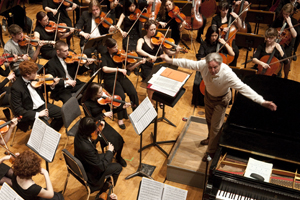Sounds of Spain
Beyond Flamenco offers a deeper glimpse of Spanish culture.
By Elizabeth Station
Photography by Lloyd DeGrane
Say “Spanish music,” and certain impressions may come to mind: clicking castanets, flashy flamenco guitars, and the Concierto de Aranjuez as soundtrack to a car commercial with Ricardo Montalban. A three-day March festival, Beyond Flamenco: Finding Spain in Music, challenged those stereotypes. Focusing on early 20th-century classical music and drawing on art, literature, and history, the program invited University of Chicago audiences to replace clichés with a deeper understanding of Spanish culture.
Politically, Spain has a modern, cosmopolitan image. A socialist-led democracy, it assumed the presidency of the European Union this year. Yet the country’s cultural identity abroad is often reduced to an exotic caricature. Since the 19th century, outsiders have seen it as “the Spain of Carmen: bullfighters, poverty, flies, and passion,” wrote novelist Antonio Muñoz Molina in the festival program.
Beyond Flamenco, cosponsored by the University of Chicago Presents concert series and the nonprofit Instituto Cervantes of Chicago, provided a more authentic view. “Even in Spain, I don’t think anybody has attempted such an ambitious presentation of work by Spanish composers,” said conductor Angel Gil-Ordóñez, the festival’s musical director. The opening concert in Mandel Hall featured piano and chamber music by Manuel de Falla (1876–1946) and the earlier Spanish masters—such as Tomás Luis de Victoria and Antonio Soler—who inspired him. The next evening pianist Pedro Carboné performed Iberia, a four-book suite of “impressions” by Isaac Albéniz (1860–1909). On its final night the festival showcased orchestral works by Falla and two contemporaries: Joaquín Turina, who was influenced by Andalusian music, and Basque composer Jesús Guridi.

Conductor Angel Gil-Ordˇ˝ez brought the full sweep of Spanish music to the stage.
Beyond Flamenco did not debut in Chicago. Music historian and classical-music producer Joseph Horowitz conceived the festival with Gil-Ordóñez and Muñoz Molina and had presented it before in Washington and New York. Their focus on understanding music in its historical and cultural context made the program a “natural fit” for U of C audiences, said Shauna Quill, executive director of University of Chicago Presents. The festival organizers, who describe themselves as “IberArtists,” were eager to collaborate with students and faculty. All events were held on campus, and the undergraduate Motet Choir and the University Symphony Orchestra rehearsed and performed with Gil-Ordóñez and Carboné. Faculty from music and Romance languages and literatures invited Horowitz and Muñoz Molina to classes, and the Smart Museum of Art showcased the works of Spanish painter and sculptor Julio González (1876–1942).
Throughout the festival, performers ceded the stage to commentators, with Horowitz and Muñoz Molina acting as intellectual guides to the music. After the Chicago Chamber Musicians played Falla’s Concerto for Keyboard and Five Instruments on opening night, Muñoz Molina put the piece in context. Dense and sometimes dissonant, the concerto is “deeply Spanish, in a nonstereotypical way, and deeply avant-garde and international,” he said. Although Falla’s devout Catholicism made him “an unlikely modernist,” he finished the work in 1926, “when [Federico] García Lorca was publishing his first poems, [Salvador] Dalí was starting to paint his first revolutionary paintings, and Luis Buñuel was planning Un Chien Andalou,” a groundbreaking surrealist film.
For Muñoz Molina, two events signaled the cultural effervescence and engagement that defined Spain in the early 20th century. In 1906 Santiago Ramón y Cajal won the Nobel Prize for his pioneering neuroscience work; a year later Pablo Picasso shocked the Paris art world with the cubist painting Les Demoiselles d’Avignon. Politically, Spain careened from monarchy to military dictatorship to parliamentary republic. Conservatives rejected the country’s “Europeanization” and the secular culture and anticlerical politics of the left.
The conflict between nationalists and republicans deepened, and the country’s brief modernist experiment would come to an end with the Spanish Civil War (1936–39). After his friend García Lorca was assassinated, Falla, the composer of Nights in the Gardens of Spain, left for exile in Argentina. Even before the conservative triumph, many Spanish artists and musicians had “voted with their feet” by moving abroad. Albéniz, who was Catalan, spent most of his life in France, writing Iberia there. After his death in 1909, his difficult, demanding piano works became popular as slick orchestrations and transcriptions for classical guitar.
In the decades after the civil war, mainstream classical works like Joaquín Rodrigo’s Concierto de Aranjuez would become synonymous with Spanish culture. By embracing more traditional artists and composers, Francisco Franco’s 36-year dictatorship tried “to erase the years of modernity,” Muñoz Molina told a festival audience. The move away from challenging, experimental musical styles represented “a country attempting to sabotage its own cultural heritage,” added Horowitz.
After Franco’s 1975 death, said Muñoz Molina, “our generation tried again to open up the country and find our own voices. We weren’t supposed to connect back to the example of those who had first shattered romantic stereotypes.” But with democracy’s return to Spain, musicians and artists have been free to reclaim their modernist roots.
